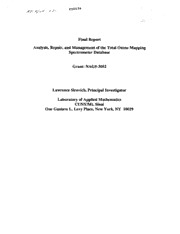
NASA Technical Reports Server (NTRS) 20000011197: Analysis, Repair, and Management of the Total Ozone Mapping Spectrometer Database PDF
Preview NASA Technical Reports Server (NTRS) 20000011197: Analysis, Repair, and Management of the Total Ozone Mapping Spectrometer Database
206034 Final Report Analysis, Repair, and Management of the Total Ozone Mapping Spectrometer Database Grant: NAG5-3052 Lawrence Sirovich, Principal Investigator Laboratory of Applied Mathematics CUNY/Mt. Sinai One Gustave L. Levy Place, New York, NY 10029 PUBLISHED PAPERS Turbulent Spectrum of the Earth's Ozone Field. L. Sirovich, R. Everson and D. Manin, Phys. Rev. Lens., 74:2611-2614, 1995. ABSTRACT: The total ozone mapping spectrometer database is subjected to an analysis in terms of the Karhunen-Loeve empirical eigenfunctions. The concentration variance spectrum is transformed into a wavenumber spectrum, Ec(k). In terms of the wave number, Ec(k) is shown to be O(k m) in the inverse cascade regime, and O(k -2) in the enstrophy cascade regime with the spectral knee at the wave number of baroclinic instability. The spectrum is related to known geophysical phenomena and shown to be consistent with physical dimensional reasoning for the problem. The appropriate Reynolds number for the phenomena is Re -- 101°. Karhunen-Lo_ve Procedure for Gappy Data. R. Everson and L. Sirovich, J. Opt. Soc. Am., 12:1657-1664, 1995 ABSTRACT: The problem of using the Karhunen- Lo_ve transform with partial data is addressed. Given a set of empirical eigenfunctions, we show how to recover the modal coefficients for each gappy snapshot by a least-squares procedure. This method gives an unbiased estimate of the data that lie in the gaps and permits gaps to be filled in a reasonable manner. In addition, a scheme is advanced for finding empirical eigenfunctions from gappy data. It is shown numerically that this procedure obtains spectra and eigenfunctions that are close to those obtained from unmarred data. An Empirical Eigenfunction Analysis of Sea Surface Temperatures in the Western North Atlantic. R. Everson, P. CorniUon, L. Sirovich and A. Webber, J. Physical Oceanography, 27:468-479, 1997. ABSTRACT: The empirical orthogonal function decomposition is used to analyze time records of AVHRR sea surface temperature observations of the western North Atlantic from 32.9 ° to 43.6°N, 62.7 ° to 76.3°W. A manually declouded dataset covering the spring of 1985 is analyzed. The majority (80%) of the variance about the mean is accounted for by an empirical eigenfunction, which is identified with seasonal warming. This eigenfunction shows that the shelf water, excluding Georges Bank, warms the most rapidly; the surface water of the Gulf of Maine warms a little less rapidly and the Gulf Stream and Sargasso Sea surface water warm the least rapidly. The SST of the Gulf Stream is also shown to behave more like that at 30°N than like Sargasso Sea water immediately to its south (~35°N). ThesecondEOFisfoundtobeasmallcorrectiontothegeneralwarmingrate describedbythefirstEOF. ThethirdandfourthEOFsaredeterminedprimarilyby meanderpropagation.Observationswithpartialcloudcoverfromtheperiod1985to 1991arealsoanalyzed.Again,thedominanteffectisidentifiedasseasonawl arming. REPORTS A Forecast/Backcast Method for Filling Gaps in TOMS Ozone Data, D. Manin, L. Sirovich, R. Everson, G. Labow and P.K. Bhartia. Filling Gaps in TOMS Ozone Data, R. Everson, D. Manin, L. Sirovich and P.K. Bhartia. Analysis, Management and Repair of TOMS database, D. Manin, R. Everson, P.K. Bhartia and L. Sirovich. Interpolation with Optimal Linear Predictor for TOMS Ozone Field, P.K. Bhartia, R. Everson, D. Manin and L. Sirovich. Construction of Synoptic Ozone Fields from TOMS Data, D. Manin, L. Sirovich, R. Everson, G. Labow and P.K. Bhartia. Background In March 1995 we published a paper (L. Sirovich, R. Everson, and D. Manin, Turbulent Spectrum of the Earth's Ozone Field, Phys. Rev. Lett., 74(13), 2611), where we reported the results of the analysis of TOMS database in terms of the Karhunen-Loeve empirical eigenfunctions. The concentration variance spectrum was transformed into a wavenumber spectrum, E,(k). In terms of the wave number, E,(k) was shown to be O(k -2j3) in the inverse cascade regime (large scales), and O(k -2) in the enstrophy cascade regime (smaller scales) with the spectral knee at the wave number of the baroclinic instability. The small-scale portion slope differed from the theoretical predictions of Batchelor, according to which the spectral slope should be -1. The steeper, -2 slope was shown to be defined by the dominant role of curvilinear near-discontinuities (sharp changes) in the ozone concentration fields. Results In the ensuing period we were able to demonstrate that the origin of these filamentous patterns resulted from the action of synoptic-scale vortical velocity field on the global-scale background gradient of ozone concentration in the meridional direction. Hyperbolic flow patterns between long-lived atmospheric vortices bring together air parcels from different latitudes, thus creating large gradients along the separatrices leaving the hyperbolic (stagnation) point. This result is further confirmed by the KL analysis of the ozone field in the equatorial region, where the background concentration gradient vanishes. The spectral slope in this region has been found to lie close to -1, in agreement with Batchelor's prediction. Another outcome of this result is that it at least provides indirect evidence about the kinetic energy spectrum of the atmospheric turbulence in the range of scales approximately 200 to 2000km. Namely, Batchelor's analysis is based on the assumption that the velocity field is large-scale, that is the kinetic energy spectrum decays as O(k -3) or steeper. Since the scalar spectrum is confh-med, this also supports this form of the kinetic energy spectrum. The study of equatorial regions of TOMS data revealed the efficiency of the KL method is in detecting and separating a wave-like measurement artifact inherently present in the dataset due to the non-perfect correction for cross-track bias. Just two to three eigenfunctions represent the error, which makes it possible to enhance the data by reconstituting it from the data by eliminating the subspace of artifactual eigenfunctions. This represents a highly efficient means for achieving an improved rendering of the data. This has been implemented on the database. A wide range of techniques and algorithms have been developed for the repair and extension of the TOMS database. Inparticularwehavetreatedthefilling inoflostpixelsandtheintroductionofa timeinterpolateddatabase.ThelatterpermitsconstructionofsynopticTOMSdata. Anotherfeatureofthesemethodsistheabilitytoperformshorttermpredictionofozone levels.A full descriptionofallofthesemethodsiscontainedinthecitedreports.A full collectionofthesereportshavebeenforwardedtoP.K.Bhartia,theNASAscientific officeronthisproject.
